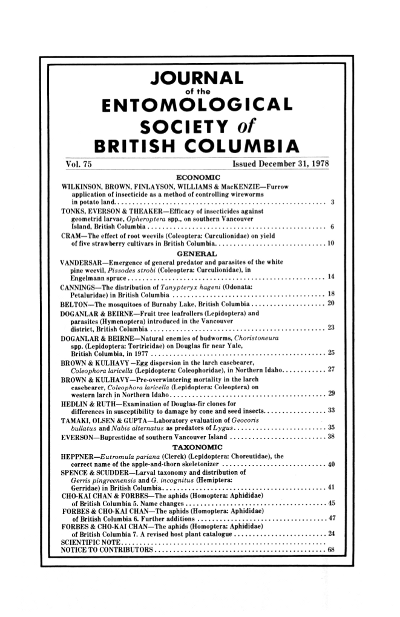Emergence of predator and parasites of the white pine weevil, <i>Pissodes strobi</i> (Coleoptera: Curculionidae), from Engelmann spruce
Keywords:
white pine weevil, <i>Pissodes strobi</i>, Coleoptera, Curculionidae, Engelmann spruceAbstract
Adult insects of 13 species emerged from 153 leaders of Engelmann spruce attacked by <i>Pissodes strobi</i> at two British Columbia locations. The most abundant species was the dipteran, <i>Lonchaea corticis</i>, a scavenger and predator of immature <i>P. strobi</i>. The most important primary parasites that attack 4th-instar larvae and pupae were the hymenopterans, <i>Dolichomitus terebrans nubilipennis</i>, <i>Bracon pini</i>, <i>Eurytoma pissodis</i>, and <i>Rhopalicus pulchripennis</i>. Competition for suitable hosts appears greatest between the two last-named species, since females exhibited agonistic behaviour when searching for oviposition sites.References
Beaver, R.A. 1967. Hymenoptera associated with elm bark beetles in Wytham Wood, Berks. Trans. Soc. British Entomol. 17:141-150.
Bushing, R.W. 1965. A synoptic list of the parasites of Scolytidae (Coleoptera) in North America north of Mexico. Can. Entomol. 97:449-492.
Harman, D.M. and H.M. Kulman. 1968. Biology and natural control of the white pine weevil in Virginia. Ann. Entomol. Soc. Amer. 61:280-285.
Harman, D.M. and H.M. Kulman. 1967. Parasites and predators of the white-pine weevil, Pissodes strobi (Peck). Univ. Maryland. Nat. Res. Inst. Contrib. 323, 35 pp.
Stevenson, R.E. 1967. Notes on the biology of the Engelmann spruce weevil, Pissodes engelmanni (Curculionidae: Coleoptera) and its parasites and predators. Can. Entomol. 99:201-213.
Downloads
Published
Issue
Section
License
Authors who publish with the Journal of the Entomological Society of British Columbia agree to the following terms:
-Authors retain copyright and grant the journal right of first publication with the work simultaneously licensed under a Creative Commons Attribution License that allows others to share the work with an acknowledgement of the work's authorship and initial publication in this journal.
-Authors are able to enter into separate, additional contractual arrangements for the non-exclusive distribution of the journal's published version of the work (e.g., post it to an institutional repository or publish it in a book), with an acknowledgement of its initial publication in this journal.
-Authors are permitted and encouraged to post their work online (e.g., in institutional repositories or on their website) prior to and during the submission process, as it can lead to productive exchanges, as well as earlier and greater citation of published work (See The Effect of Open Access).


